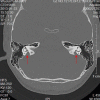Variations in the Mutational Spectrum in Nonsyndromic Hearing Impairment: A study of the Special Schools for the Deaf in Southern China
- PMID: 31347505
- PMCID: PMC6750793
- DOI: 10.5152/iao.2019.6512
Variations in the Mutational Spectrum in Nonsyndromic Hearing Impairment: A study of the Special Schools for the Deaf in Southern China
Abstract
Objectives: To explore the characteristics of variations in patients with nonsyndromic hearing impairment (NSHI) in Southern China to supply a theoretical basis for screening, intervention, and prevention.
Materials and methods: A total of 634 hearing-impaired students from the special schools for the deaf and 220 normal-hearing individuals in South China were tested using an allele-specific polymerase chain reaction-based universal array, and the screened SLC26A4 mutation carrier was examined using computed tomography. The pathogenesis of deafness was analyzed using pathography and objective hearing tests.
Results: In total, 151 patients with NSHI carried pathogenic mutations in the screening chip, and the carrier rate was 23.82% (151/634) in the studied population. Of the 151 screened carriers, 65 (10.25%) patients harbored homozygous or homoplasmy mutated genes associated with autosomal recessive hearing loss; 36 (5.68%) patients with mutant alleles were homozygous for the GJB2 c.235delC mutation and 27 (4.26%) were heterozygous. Furthermore, 18 (2.84%) patients were homozygous with mutant alleles for the SLC26A4 c.919-2A>G mutation and 43 (6.78%) were heterozygous; 7 (1.10%) patients were homoplasmy mutation carriers of MT-RNR1 gene. There was 1 SLC26A4 c.919-2A>G and 1 GJB2 c.235delC heterozygous mutant allele in the group of 220 normal-hearing individuals.
Conclusion: GJB2 and SLC26A4 were much more prevalent than MT-RNR1 and GJB3 in South China according to this gene chip. Minuscule differences in the mutation spectrum or prevalence of GJB2 c.235delC and SLC26A4 c.919-2A>G were found in our study; furthermore, a relatively high incidence of variations was observed among these individuals with NSHI.
Conflict of interest statement
Figures
Similar articles
-
Mutation analysis of common deafness-causing genes among 506 patients with nonsyndromic hearing loss from Wenzhou city, China.Int J Pediatr Otorhinolaryngol. 2019 Jul;122:185-190. doi: 10.1016/j.ijporl.2019.04.024. Epub 2019 Apr 21. Int J Pediatr Otorhinolaryngol. 2019. PMID: 31035178
-
The mutation frequencies of GJB2, GJB3, SLC26A4 and MT-RNR1 of patients with severe to profound sensorineural hearing loss in northwest China.Int J Pediatr Otorhinolaryngol. 2020 Sep;136:110143. doi: 10.1016/j.ijporl.2020.110143. Epub 2020 May 28. Int J Pediatr Otorhinolaryngol. 2020. PMID: 32645618
-
[Genotype and clinical phenotype analysis of 42 patients with delayed nonsyndromic hearing loss].Lin Chuang Er Bi Yan Hou Tou Jing Wai Ke Za Zhi. 2021 Feb;35(2):131-136. doi: 10.13201/j.issn.2096-7993.2021.02.009. Lin Chuang Er Bi Yan Hou Tou Jing Wai Ke Za Zhi. 2021. PMID: 33540994 Free PMC article. Chinese.
-
Carrier frequencies of hearing loss variants in newborns of China: A meta-analysis.J Evid Based Med. 2019 Feb;12(1):40-50. doi: 10.1111/jebm.12305. Epub 2018 Jul 2. J Evid Based Med. 2019. PMID: 29968368 Review.
-
A de novo heterozygous variant in ACOX1 gene cause Mitchell syndrome: the first case in China and literature review.BMC Med Genomics. 2023 Jul 3;16(1):156. doi: 10.1186/s12920-023-01577-w. BMC Med Genomics. 2023. PMID: 37400800 Free PMC article. Review.
Cited by
-
Low frequency of SLC26A4 c.919-2A > G variant among patients with nonsyndromic hearing loss in Yunnan of Southwest China.BMC Med Genomics. 2024 Feb 20;17(1):55. doi: 10.1186/s12920-024-01829-3. BMC Med Genomics. 2024. PMID: 38378613 Free PMC article.
-
Byōseki and pathography: Their commonalities and differences.PCN Rep. 2025 Apr 21;4(2):e70102. doi: 10.1002/pcn5.70102. eCollection 2025 Jun. PCN Rep. 2025. PMID: 40265151 Free PMC article. Review.
References
-
- Dai P, Yu F, Han B, Wu H, Yuan YY, Li Q, et al. [Features of nationwide distribution and frequency of a common gap junction beta-2 gene mutation in China]. Zhonghua Er Bi Yan Hou Tou Jing Wai Ke Za Zhi. 2007;42:804–8. - PubMed
-
- Wang GJ, Yuan YY, Han B, Huang SS, Kang DY, Zhang X, et al. Prevalence of common genetic mutations in 839 patients with severe and profound hearing loss. Chinese Journal of Otology. 2010;4:392–6.
Publication types
MeSH terms
Substances
Supplementary concepts
LinkOut - more resources
Full Text Sources
Medical





